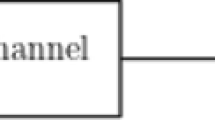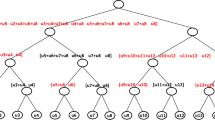Abstract
This paper investigates joint design and optimization of both low density parity check (LDPC) codes and M-algorithm based detectors including iterative tree search (ITS) and soft-output M-algorithm (SOMA) in multiple-input multiple-output (MIMO) systems via the tool of extrinsic information transfer (EXIT) charts. First, we present EXIT analysis for ITS and SOMA. We indicate that the extrinsic information transfer curves of ITS obtained by Monte Carlo simulations based on output log-likelihood rations are not true EXIT curves, and the explanation for such a phenomenon is given, while for SOMA, the true EXIT curves can be computed, enabling the code design. Then, we propose a new design rule and method for LDPC code degree profile optimization in MIMO systems. The algorithm can make the EXIT curves of the inner decoder and outer decoder match each other properly, and can easily attain the desired code with the target rate. Also, it can transform the optimization problem into a linear one, which is computationally simple. The significance of the proposed optimization approach is validated by the simulation results that the optimized codes perform much better than standard non-optimized ones when used together with SOMA detector.
Similar content being viewed by others
References
Foschini G J, Gans M J. On limits of wireless communications in a fading environment when using multiple antennas. Wireless Pers Commun, 1998, 6(3): 311–333
You X H, Chen G A, Chen M, et al. The FuTURE project in China. IEEE Commun Mag, 2005, 43(1): 70–75
Zhang P, Tao X F, Zhang J H, et al. The vision from FuTURE beyond 3G TDD. IEEE Commun Mag, 2005, 43(1): 38–44
Haykin S, Sellathurai M, de Jong Y L C, et al. Turbo-MIMO for wireless communications. IEEE Commun Mag, 2004, 42(10): 48–53
Lu B, Yue G, Wang X. Performance analysis and design optimization of LDPC-coded MIMO OFDM systems. IEEE Trans Signal Process, 2004, 52(2): 348–361
ten Brink S, Kramer G, Ashikhmin A. Design of low-density parity-check codes for modulation and detection. IEEE Trans Commun, 2004, 52(4): 670–678
Hou J, Siegel P H, Milstein L B. Design of multi-input multioutput systems based on low-density parity-check codes. IEEE Trans Commun, 2005, 53(4): 601–611
Zheng J, Rao B D. LDPC-coded MIMO systems with unknown block fading channels: soft MIMO detector design, channel estimation, and code optimization. IEEE Trans Signal Process, 2006, 54(4): 1504–1518
You M H, Tao X F, Zhang P, et al. Novel low-complexity iterative receiver for MIMO-BICM systems (in Chinese). Acta Electr Sin, 2007, 35(6A): 127–130
Hochwald B, ten Brink S. Achieving near-capacity on a multiple-antenna channel. IEEE Trans Commun, 2003, 51(3): 389–399
Hagenauer J, Kuhn C. The list-sequential (LISS) algorithm and its application. IEEE Trans Commun, 2007, 55(5): 918–928
Steigrimsson B, Luo Z Q, Wong K M. Soft quasi-maximumlikelihood detection for multiple-antenna wireless channels. IEEE Trans Signal Process, 2003, 51(11): 2710–2719
de Jong Y L C, Willink T J. Iterative tree search detection for MIMO wireless systems. In: Proceedings of IEEE VTC, Vancouver, BC, Canada: IEEE Press, 2002. 1041–1045
de Jong Y L C, Willink T J. Iterative tree search detection for MIMO wireless systems. IEEE Trans Commun, 2005, 53(6): 930–935
Wong K K Y. The soft-output M-algorithm and its applications. PhD Dissertation. Kingston: Queen’s University, 2006
Wong K K Y, McLane P J. Reduced-complexity equalization techniques for ISI and MIMO wireless channels in iterative decoding. IEEE J Select Area Commun, 2008, 26(2): 256–268
Richardson T, Urbanke R. The capacity of low density parity check codes under message passing decoding. IEEE Trans Inf Theory, 2001, 47(2): 599–618
ten Brink S. Convergence behavior of iteratively decoded parallel concatenated codes. IEEE Trans Commun, 1999, 49(10): 1727–1737
Franceschini M, Ferrari G, Raheli R, et al. Serial concatenation of LDPC codes and differential modulations. IEEE J Select Areas Commun, 2005, 23(9): 1758–1768
Tüchler M, Hagenauer J. EXIT charts of irregular codes. In: 2002 conference on Information Sciences and Systems, Princeton, NJ, 2002. 748–753
Richardson T, Shokrollahi A, Urbanke R. Design of capacity approaching irregular low-density parity check codes. IEEE Trans Inf Theory, 2001, 47(2): 619–637
Ashikhmin A, Kramer G, ten Brink S. Extrinsic information transfer functions: model and erasure Channel properties. IEEE Trans Inf Theory, 2004, 50(11): 2657–2673
Boyd S, Vandenberghe L. Convex Optimization. Cambridge, UK: Cambridge University Press, 2003
Campello J, Modha D S. Extended bit-filling and LDPC code design. In: Proceedings of IEEE Globecom, San Antonio, TX, USA: IEEE Press, 2001. 985–989
Yue G, Lu B, Wang X. Analysis and design of finite-length LDPC codes. IEEE Trans Veh Tech, 2007, 56(3): 1321–1332
Author information
Authors and Affiliations
Corresponding author
Additional information
Supported by the National Basic Research Program of China (Grant No. 2009CB320406), the National Natural Science Foundation of China (Grant No. 60872048), and Specialized Major Science and Technology Project of China (Grant Nos. 2008ZX03003-004, 2009ZX03003-009)
Rights and permissions
About this article
Cite this article
You, M., Tao, X., Cui, Q. et al. EXIT analysis of M-algorithm based MIMO detectors and LDPC code design optimization. Sci. China Ser. F-Inf. Sci. 52, 2248–2258 (2009). https://doi.org/10.1007/s11432-009-0202-x
Received:
Accepted:
Published:
Issue Date:
DOI: https://doi.org/10.1007/s11432-009-0202-x




